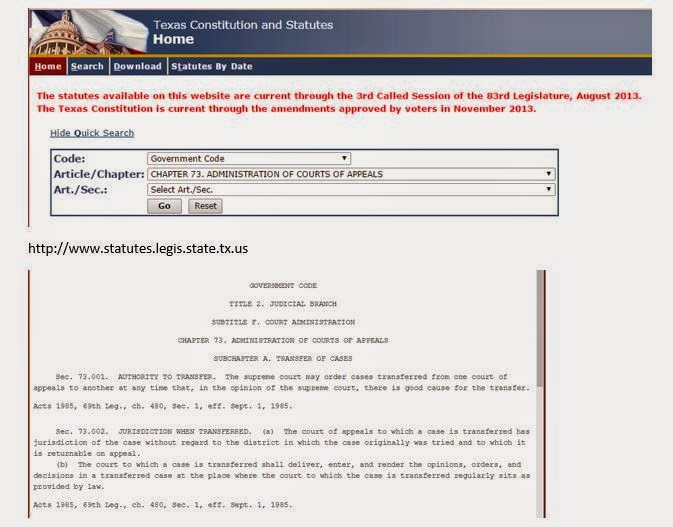TRANSFER OF CASES FROM ONE TEXAS COURT OF APPEALS TO ANOTHER
The fourteen intermediate courts of appeals in Texas vary in size between 3 and 13, but do not receive appeals in exact proportion to their share of the total number of justices statewide, which is 80. As a result, some courts of appeals end up with more cases per member than others. To meliorate the disproportionality, and to even the case-load burden, the Texas Supreme Court transfers batches of cases from courts of appeals with an excess of cases to those that are less busy.
The Supreme Court does this several times a year with administrative orders called docket-equalization orders. See TEX. GOV'T CODE ANN. § 73.001.
The cases that are transferred are not screened for the issues they raise, but are transferred based on date and filing sequence. The guiding rational is administrative convenience and efficiency in utilization of judicial resources.
The chart below shows the extent of disproportion, and the effect of equalization for Fiscal Year 2014.
STATUTORY AUTHORITY FOR TRANSFER OF APPEALS AMONG THE COAs
Texas Government Code §73.001
SAMPLE DOCKET EQUALIZATION ORDER
 |
| Link to the full-length document |
CASELAW SNIPPETS ON TRANSFER OF CASES
The Texas Supreme Court transferred this appeal from the Court of Appeals for the Fourth District of Texas to this Court pursuant to its docket equalization powers. See TEX. GOV'T CODE ANN. § 73.001 (West 2013) ("The supreme court may order cases transferred from one court of appeals to another at any time that, in the opinion of the supreme court, there is good cause for the transfer."); Order Regarding Transfer of Cases From Courts of Appeals, Misc. Docket No. 14-9121, ¶ II (Tex. June 23, 2014).
---
The Supreme Court of Texas transferred this appeal from the Third Court of Appeals in Austin to this Court pursuant to its docket-equalization authority. See TEX. GOV'T CODE ANN. § 73.001 (Vernon 2013) ("The supreme court may order cases transferred from one court of appeals to another at any time that, in the opinion of the supreme court, there is good cause for the transfer.").
IMPLICATIONS FOR APPLICATION OF COA-SPECIFIC CASELAW
In transferred cases, the receiving court is supposed to follow the binding precedent from the appellate court from which the transferred case originated. TEX.R.APP.P. 41.3. This is significant because the courts of appeal do not always see eye to eye on legal issues, and are not bound to follow each other on legal issues that have not been resolved authoritatively by the court of last resort. A transfer case can put justices in the position of having to depart from thier own precedents to give effect to a prior precedent from a sister court. But that scenario is rare.
Originally appealed to the Twelfth Court of Appeals, this case was transferred to this Court by the Texas Supreme Court pursuant to its docket equalization efforts. See TEX. GOV'T CODE ANN. § 73.001 (West 2013). We are unaware of any conflict between precedent of the Twelfth Court of Appeals and that of this Court on any relevant issue. See TEX. R. APP. P. 41.3.RELATED TERMS: Docket equalization order, transfer of cases from one court of appeals to another, caseload balancing, transfer in and transfer out, appellate caseloads, number of appeals in each and appellate district, cases per judge.
QUESTION ADDRESSED BY THIS BLOG POST:
Why do appeals get transferred to a different court of appeals?
Why does the Texas Supreme Court transfer cases from the court of appeal in which they were filed?
Which courts of appeals have cases transferred out and which courts receive them?


No comments:
Post a Comment